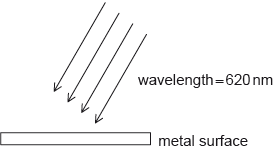| Date | November 2015 | Marks available | 1 | Reference code | 15N.3.SL.TZ0.5 |
| Level | Standard level | Paper | Paper 3 | Time zone | Time zone 0 |
| Command term | State | Question number | 5 | Adapted from | N/A |
Question
This question is about the photoelectric effect.
When light is incident on a clean metal surface, electrons can be emitted through the photoelectric effect.

Outline how the Einstein model is used to explain the photoelectric effect.
State why, although the incident light is monochromatic, the energies of the emitted electrons vary.
Explain why no electrons are emitted if the frequency of the incident light is less than a certain value, no matter how intense the light.
For monochromatic light of wavelength 620 nm a stopping potential of 1.75 V is required. Determine the minimum energy required to emit an electron from the metal surface.
Markscheme
light made of photons of energy \(E = hf\);
electrons are released immediately from the metal;
if electron gains sufficient energy (from a photon);
different electrons may be bound by a different amount of energy to the metal;
insufficient photon energy to eject surface electrons;
greater intensity means more photons but still none with enough energy;
\({E_{\max }} = (1.75 \times 1.60 \times {10^{ - 19}} = ){\text{ }}2.80 \times {10^{ - 19}}{\text{ (J)}}\);
\(\phi = \left( {hf - {E_{\max }} = 6.63 \times {{10}^{ - 34}} \times \frac{{3.00 \times {{10}^8}}}{{620 \times {{10}^{ - 9}}}} - 2.80 \times {{10}^{ - 19}} = } \right){\text{ }}4.1 \times {10^{ - 20}}{\text{ (J)}}\);
Examiners report
The general idea of the photon explanation of the photoelectric effect was well known, but only a few clearly referred to photon energy transfer. Very few could explain why monochromatic light gives varied electron energies, most referring to various frequencies of light as the reason. The common mistake was the electron gaining different amounts of energy from different frequencies (despite monochromatic being stated in the question). While threshold frequency was well understood the effect of intensity was usually overlooked. The calculation was usually well attempted.
The general idea of the photon explanation of the photoelectric effect was well known, but only a few clearly referred to photon energy transfer. Very few could explain why monochromatic light gives varied electron energies, most referring to various frequencies of light as the reason. The common mistake was the electron gaining different amounts of energy from different frequencies (despite monochromatic being stated in the question). While threshold frequency was well understood the effect of intensity was usually overlooked. The calculation was usually well attempted.
The general idea of the photon explanation of the photoelectric effect was well known, but only a few clearly referred to photon energy transfer. Very few could explain why monochromatic light gives varied electron energies, most referring to various frequencies of light as the reason. The common mistake was the electron gaining different amounts of energy from different frequencies (despite monochromatic being stated in the question). While threshold frequency was well understood the effect of intensity was usually overlooked. The calculation was usually well attempted.
The general idea of the photon explanation of the photoelectric effect was well known, but only a few clearly referred to photon energy transfer. Very few could explain why monochromatic light gives varied electron energies, most referring to various frequencies of light as the reason. The common mistake was the electron gaining different amounts of energy from different frequencies (despite monochromatic being stated in the question). While threshold frequency was well understood the effect of intensity was usually overlooked. The calculation was usually well attempted.

